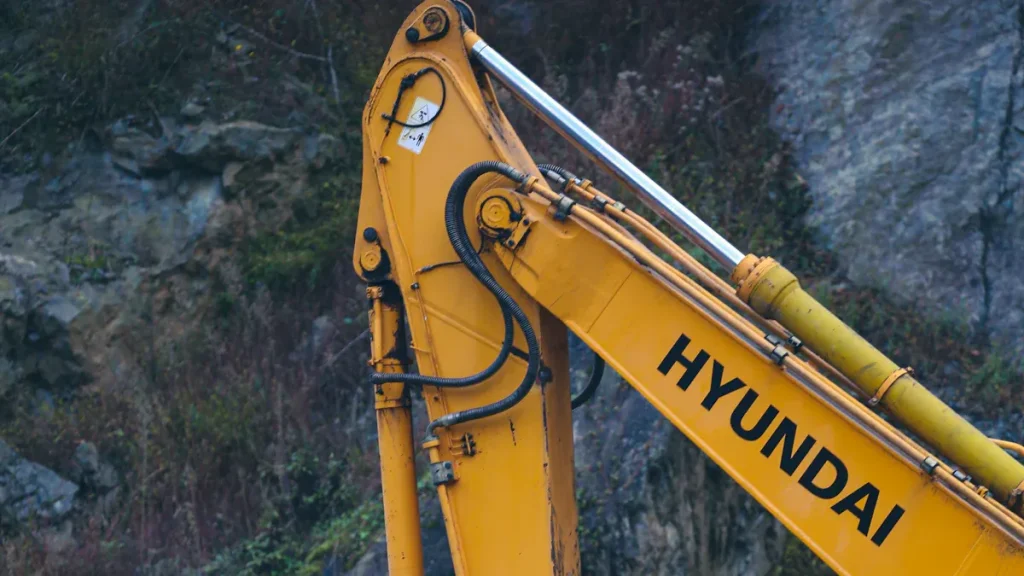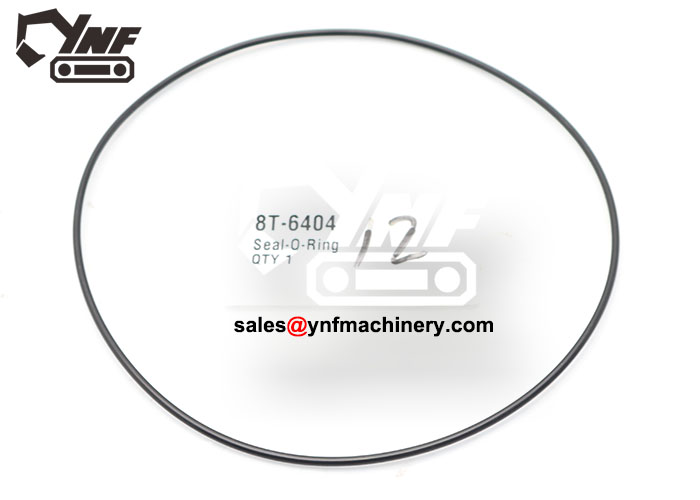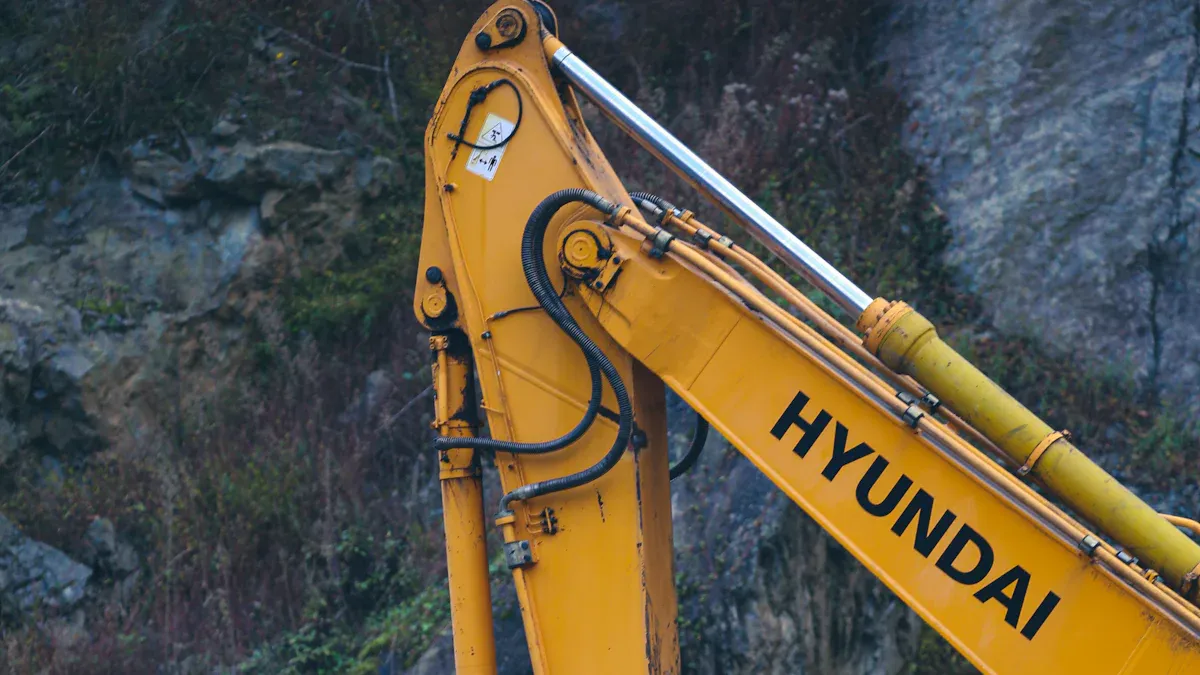
Understanding the names and jobs of excavator arm parts, including their specific names, is important. If you use or fix an excavator, knowing these excavator arm parts names helps. It gives better control, saves time, and reduces damage.
Taking care of the arm, like changing hydraulic oil often, is key. Change the oil every 2000-3000 hours to keep it working well. Good hydraulic oil can also save 5% energy. Hard-working excavator arm parts wear out faster, but strong materials last 20% longer.
Learning about excavator arm parts names helps it work its best. It also lowers the chance of expensive fixes. Knowing this lets you use the machine safely and accurately, whether digging or lifting heavy things.
Key Takeaways
Knowing the names and jobs of excavator arm parts helps you use it better. It also avoids expensive repairs.
Taking care of the machine, like changing hydraulic oil every 2000-3000 hours, keeps it running well and saves power.
The boom, stick, and bucket work as a team to dig and lift. Learning their jobs makes using the machine easier.
Hydraulic cylinders help the arm move. Checking for leaks or damage often keeps it working smoothly and lasting longer.
Picking the right tools for each job makes the excavator more useful and faster, making work simpler.
Overview of Parts of an Excavator Arm
What is the Excavator Arm?
The excavator arm is a key part of the machine. It has several connected parts like the boom, stick (or dipper), and bucket. These parts work together to dig, lift, and move things. The arm is attached to the boom and powered by hydraulic cylinders. These cylinders give the arm strength to move and lift heavy loads. This setup helps the arm do its job accurately and handle tough tasks.
The stick, also called the dipper, links the bucket to the boom. It helps the excavator dig deeper or reach farther. Hydraulic cylinders move the stick, letting you extend or pull back the bucket. The boom controls how far the excavator can reach. It lifts or lowers the arm and bucket, making it important for digging or lifting heavy items.
Role of the Excavator Arm in Machine Operation
The excavator arm is very important for how the machine works. It is the main tool for digging, lifting, or moving materials. Its design makes sure it can handle tough jobs while staying precise and efficient.
Hydraulic cylinders make the arm move, so you can control the boom, stick, and bucket easily. This teamwork is needed for smooth operations. For example, when digging, the arm must push through hard soil. Studies show that the arm’s strength and design affect how well the excavator works and how much fuel it uses. By learning how the arm works, you can use the machine better and save time, making it more efficient.
Tip: Check the excavator arm often. Look at the hydraulic cylinders and replace worn parts. This keeps it working longer and better.
Main Components of an Excavator Arm
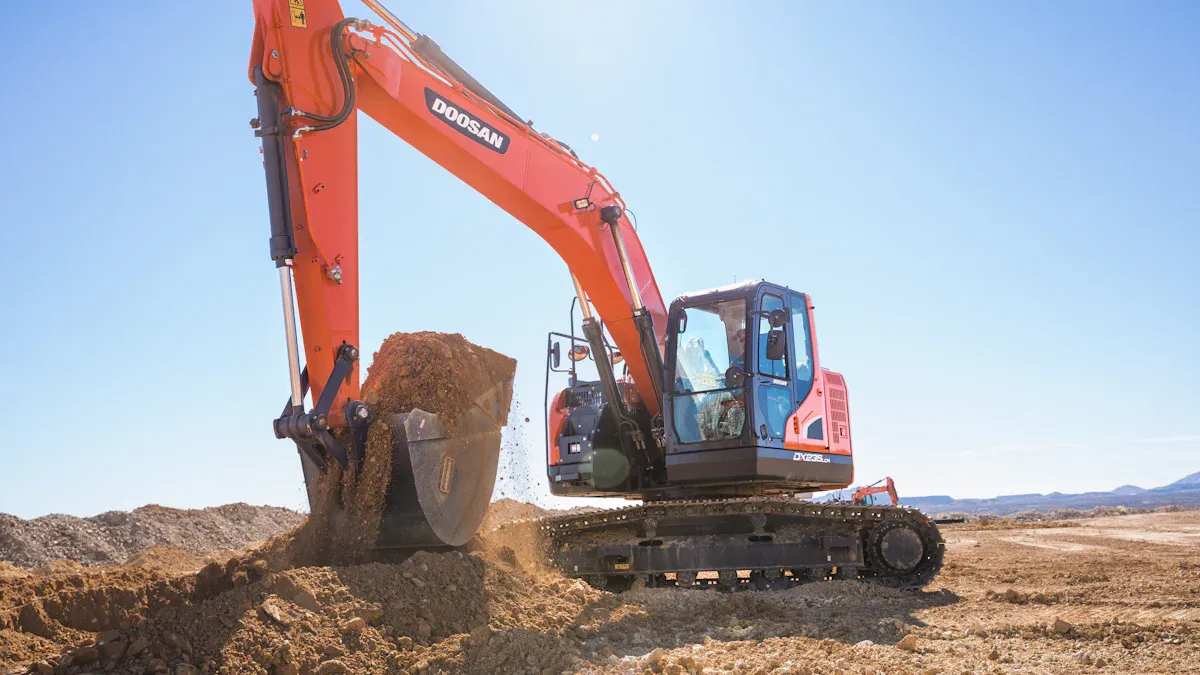
Boom
The boom is a key part of the excavator arm. It stretches out from the cab and acts as its backbone. Its main job is to give height and reach for digging or lifting. The boom connects to the stick and moves with hydraulic cylinders. These cylinders help it go up and down smoothly.
Did you know? The excavator boom is built to handle heavy stress. Its strong design makes it last longer, even in tough places like rocky areas or construction sites.
The boom’s shape affects how the machine works. A longer boom can reach farther, which is great for trenching or hard-to-reach spots. Shorter booms lift heavier loads, making them better for tough jobs. Knowing how the boom works helps you pick the right one for your tasks.
Stick/Arm
The stick, also called the arm or dipper, is another important part of the excavator arm. It links the boom to the bucket and helps with digging. The stick’s length and hydraulic system decide how deep or far the excavator can dig.
Feature | Specification |
|---|---|
Hydraulic Pressure | 343 bar (4970 psig) |
Hydraulic Flow Rate | 235 l/min (62.1 gpm) |
Stick Cylinder Bore | 150 mm (5.9 in.) |
Stick Cylinder Stroke | 1646 mm (64.8 in.) |
The stick’s hydraulic cylinder lets you control it easily. You can extend or pull back the arm smoothly. This is helpful for jobs like trenching, where accuracy matters. The stick is made to handle strong forces during digging, even in hard soil.
Pro Tip: Check the stick’s hydraulic cylinder often for leaks or damage. Good care keeps it working well and lasting longer.
Bucket
The bucket is the most noticeable part of the excavator arm. It scoops, lifts, and moves things like dirt, rocks, or debris. Buckets usually have teeth to dig into hard surfaces better.
Buckets come in different shapes and sizes for various jobs:
General-purpose buckets work well for most digging tasks.
Rock buckets are stronger for tough, heavy materials.
Trenching buckets are narrow, perfect for digging small trenches.
Taking care of buckets makes them work better and last longer. Check for worn teeth or cracks to avoid big repairs. A well-kept bucket saves money and improves performance.
Fun Fact: A sharp bucket helps the excavator dig faster and use less fuel. This saves time and lowers costs.
By learning about the boom, stick, and bucket, you understand how the excavator arm works. These parts are made to handle hard jobs while staying accurate and efficient.
Hydraulic Cylinders
Hydraulic cylinders make the excavator arm move and work. They turn pressurized hydraulic fluid into force, allowing control of the boom, stick, and bucket. Without them, the arm wouldn’t have the power or flexibility for tough jobs.
How Hydraulic Cylinders Work
Hydraulic cylinders use pressurized fluid to push a piston inside. This creates the force needed to move the arm’s parts. Each cylinder has a job:
The boom cylinder moves the boom up and down.
The stick cylinder pushes or pulls the stick.
The bucket cylinder tilts and rotates the bucket.
These cylinders work together for smooth operation. For example, when digging, the boom cylinder lifts the arm, while the stick and bucket cylinders adjust the bucket’s depth and angle.
Importance of Design and Maintenance
Hydraulic cylinders handle high pressure during use. System pressures can reach 6,000 psi, with spikes up to 18,000 psi. To manage this, cylinders are built to last about 8,000 hours under normal use. However, heavy loads or improper use can wear them out faster.
To keep cylinders in good shape, follow these tips:
Inspect often: Look for leaks, dents, or scratches.
Check seals and rods: Make sure they aren’t damaged to avoid fluid loss.
Keep clean: Remove dirt to prevent system contamination.
Tip: Regular care helps hydraulic cylinders last longer and work better.
Why Hydraulic Cylinders Matter
Hydraulic cylinders affect how well your excavator works. A well-kept cylinder ensures smooth movement, less downtime, and fewer repairs. By knowing how they work and maintaining them, you can make your machine last longer and perform better.
How Main Parts of an Excavator Arm Work Together
Coordination Between Boom, Stick, and Bucket
The boom, stick, and bucket are the main parts of the excavator arm. They work together to dig, lift, and move materials. Each part has its own job, but their teamwork makes the machine run smoothly.
The boom gives height and reach to position the arm. The stick moves in and out to adjust how far or deep the bucket goes. The bucket scoops, carries, or dumps materials. When these parts work together, you can dig trenches or load trucks with precision.
Engineers study how these parts interact using dynamic models. These models show how the boom, stick, bucket, and hydraulic cylinders work as a team. Complete models are more accurate than simple ones. They help improve how the machine performs.
Aspect | Description |
|---|---|
Focus | Dynamic modeling of the working mechanism of a face-shovel hydraulic excavator. |
Components | Includes boom, stick, bucket, and driving hydraulic cylinders. |
Methodology | Establishes both simplified and complete dynamic models for analysis. |
Findings | Complete dynamic model shows improved accuracy over simplified model. |
Significance | Provides a foundation for performance analysis and design of excavator working mechanisms. |
Stress tests show why coordination matters. The boom handles the most stress at its base. The stick and bucket deal with less stress. This balance keeps all parts working without overloading one.
Component | Maximum Stress (MPa) | Notes |
|---|---|---|
Boom | 224.65 | Maximum stress at the connection point |
Arm | N/A | Stresses were relatively small |
Bucket | N/A | Not specified in the data |
Knowing how these parts work together helps you use the machine better. Good coordination lowers wear, saves fuel, and boosts performance.
Tip: Move the boom, stick, and bucket smoothly. This reduces stress on the parts and improves accuracy.
Role of Hydraulic Cylinders in Movement
Hydraulic cylinders power the movement of the excavator arm. They turn hydraulic pressure into energy, letting you control the boom, stick, and bucket easily. Without them, the arm wouldn’t have the strength or flexibility for tough jobs.
Each cylinder has a specific job:
The boom cylinder lifts and lowers the boom.
The stick cylinder moves the stick in and out.
The bucket cylinder tilts and turns the bucket.
These cylinders work together for smooth movements. For example, when digging, the boom cylinder raises the arm, the stick cylinder adjusts depth, and the bucket cylinder scoops material. This teamwork makes hard tasks easier.
Studies on hybrid excavators show how hydraulic cylinders save energy. New systems cut energy use by 9.44% and improve energy recovery by 10.51% during boom operations. This shows how cylinders help save fuel and improve efficiency.
To keep cylinders working well, check them often. Look for leaks, dents, or scratches. Make sure seals and rods are in good shape. Clean them to avoid dirt causing damage.
Pro Tip: Use good-quality hydraulic fluid and change it as recommended. This helps your cylinders last longer and keeps the machine running well.
By learning about hydraulic cylinders, you see how important they are. Taking care of them ensures smoother movements, fewer breakdowns, and a longer-lasting machine.
Common Attachments for Excavator Arms
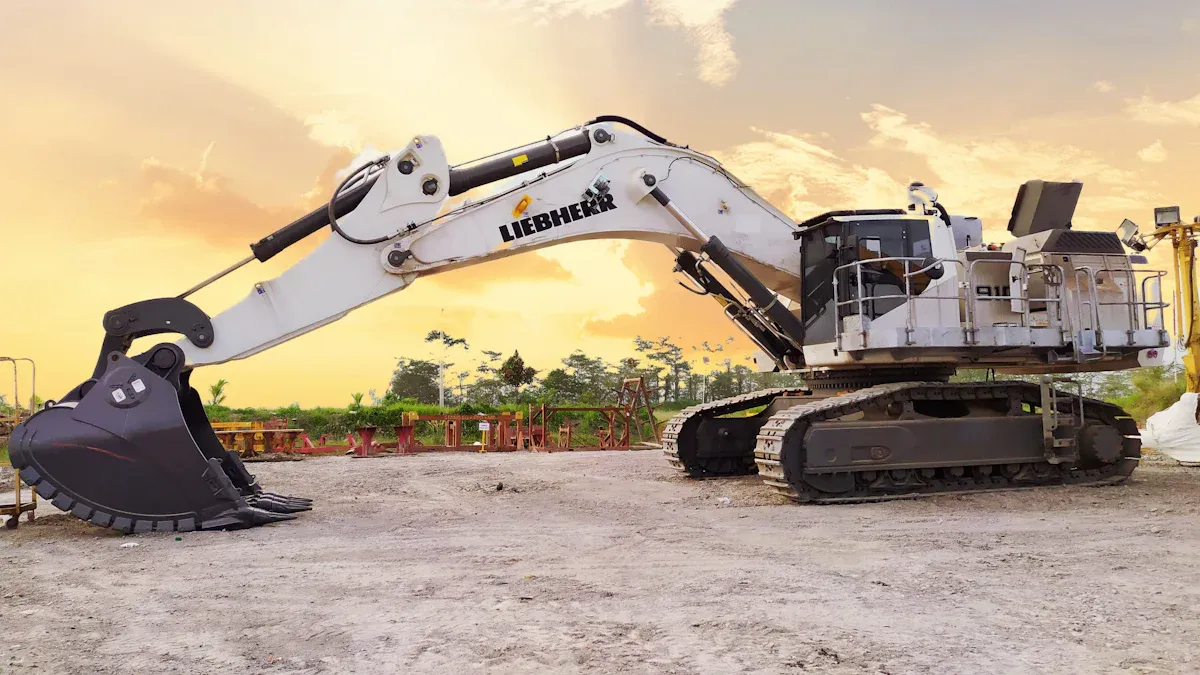
Types of Attachments (e.g., Grapples, Breakers, Augers)
Attachments make excavators more useful for different tasks. Each one is made for a specific job, helping you work faster. Here are some common attachments:
Attachment Type | Uses | Key Features |
|---|---|---|
Grapples | Moving logs, debris, or scrap | Strong grip, different sizes, hydraulic or manual options |
Breakers | Breaking concrete, asphalt, or rocks | Power range: 200–15,000 ft-lbs, speed: 100–1,500 hits per minute |
Augers | Drilling holes for posts or foundations | Depth up to 10 ft, width: 4–36 in., powered by hydraulic or mechanical systems |
Newer excavators, like the CASE E Series, improve how attachments work. They use Hydraulic Flow Control Balance to make movements smoother and more efficient. These machines can also save settings for up to ten attachments. This reduces setup time and keeps work running smoothly.
Functions and Uses of Attachments
Attachments turn excavators into tools for many industries. Grapples are great for grabbing and moving logs or scrap in recycling. Breakers are perfect for smashing concrete or asphalt during demolition. Augers drill holes for things like fence posts or utility poles.
In construction, breakers help tear down buildings quickly. A used excavator with a breaker can easily crush concrete walls. In farming, rippers break hard soil and clear land, making them useful for roads or planting.
Caterpillar excavators add advanced features to make attachments even better. Systems like Cat Grade give real-time tips to save fuel and boost productivity. Tools like Boom Assist and Swing Assist make movements smoother. A simple interface makes switching attachments easier.
Picking the right attachment helps you get the most from your excavator. Whether digging, lifting, or breaking, attachments make your machine more flexible and effective.
Knowing the names and jobs of excavator arm parts is helpful. The arm links the boom and bucket, allowing accurate digging. The bucket is made for digging and carrying things. It comes in different shapes for various jobs. Hydraulic systems make these parts move with power and precision.
Learning this can make you work better and protect the machine. Find out more about taking care of excavators to keep them working well and lasting longer.
FAQ
What is the difference between a boom and a stick on an excavator arm?
The boom gives height and reach for digging or lifting. The stick, also called the dipper, moves in and out. It controls how deep or far the bucket digs. Both work together to position the bucket accurately.
How often should you inspect hydraulic cylinders?
Check hydraulic cylinders every week. Look for leaks, dents, or scratches. Inspect seals and rods for any damage. Regular checks help avoid expensive repairs and keep the machine working well.
Can you use any bucket with an excavator?
No, buckets must match the excavator’s size and job type. For example, trenching buckets are good for narrow trenches. Rock buckets are better for heavy-duty tasks. Always check if the bucket fits your machine.
Why do excavator buckets have teeth?
Bucket teeth make digging easier. They break through hard soil or rocks. Worn teeth slow down digging, so replace them when needed to keep performance high.
What are the benefits of using attachments on an excavator?
Attachments make excavators more useful for different jobs. Grapples grab debris, breakers smash concrete, and augers drill holes. Using the right attachment saves time and improves efficiency.
Tip: Follow the manufacturer’s instructions when changing attachments. This ensures safe and smooth operation.

